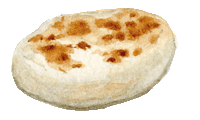Langos

Form: Bun
Country of origin: Hungary
What distinguishes it from other methods of bread making: Wheat flour is mixed with mashed potatoes
Category of bread: (7) Langos falls into the category of breads fried in oil; it may or may not be filled or topped. This category also includes the Jamaican bammy and the Bangladeshi luchi
Particularity: Also referred to as Hungarian pizza
Ingredients: 2/3 flour and 1/3 mashed potatoes; milk; water; yeast or leaven; salt; sugar (just a bit)

Hungary
Although it is not known for its bread, Hungary was once the capital of all the bread baking nations. The invention of cylinder mills in the 19th century in fact put it at the top of the countries producing high-quality flours in Europe. It was Hungarian flour that prompted the Viennese bakers to make the Viennoiseries that became so famous all over the world. The overwhelming success of the Austrian Christophe Auguste Zang’s Boulangerie Viennoise bakery in Paris in 1838 or 1839 is in part due to his decision to use Hungarian flour.
Hungarian bread brings with it many influences. The small langos are champions of the fast food industry in Hungary and Austria today, and seem almost surely to have been inherited from the Turkish invaders, even if the Hungarians prefer to forget that detail. But it is also said to be an ancestor of the Italian focaccia, what the Romans called panis focacius. The recipe has undoubtedly evolved over time, before becoming the delicious flour and potato griddlecake, fried in oil, it is today.
Mashed potatoes made with milk are mixed with flour, leaven or yeast, salt and sugar. The dough is left to rise in a covered bowl, near a source of heat, for about 2 hours, turning it over after the first hour. Once the air is pressed out of it, it is divided to make small griddlecakes that are then fried in oil. One might ask if it is not somehow related to blinis.

